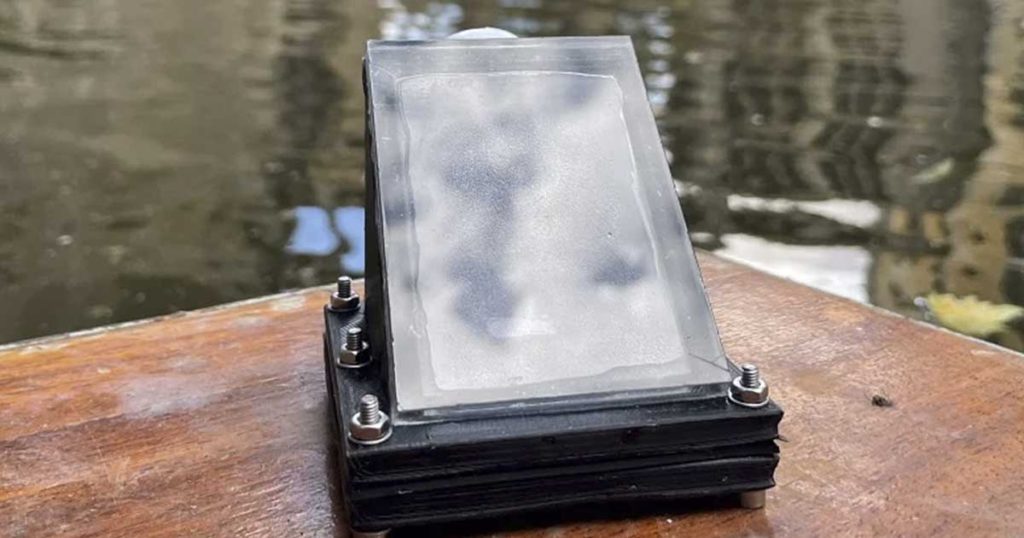Researchers at the University of Cambridge have engineered a groundbreaking solar device capable of transforming contaminated water into clean drinking water and hydrogen fuel.1 This breakthrough device exemplifies the power of innovation in addressing pressing global concerns. Its multifaceted approach to clean water production and renewable energy generation sets a precedent for future technological advancements.
The success of the University of Cambridge’s device serves as a rallying call for continued investment, research, and commitment towards similar transformative technologies. By amplifying innovation and sustainability, we pave a path towards a more equitable and resilient world.
The Solar Device’s Ingenious Design
Inspired by photosynthesis, this device, unlike previous versions, doesn’t rely on pure water sources but effectively operates with polluted or seawater.2 Its success was evident in tests conducted using severely polluted water, seawater, and even water from the River Cam in central Cambridge.
Professor Erwin Reisner, leading the research, envisions a future where innovations like this device lead the charge toward a circular economy and sustainable living. Integrating solutions that tackle climate change, pollution, and health issues in one stroke holds the potential to revolutionize global sustainability efforts.

The challenges of merging water purification and solar fuel production were tackled by Dr. Chanon Pornrungroj and Ariffin Mohamad Annuar. They developed a photocatalyst placed on a nanostructured carbon mesh that efficiently absorbs light and heat to generate water vapor for hydrogen production.
By efficiently converting polluted water into clean drinking water and green hydrogen, this device presents a multipurpose solution to pressing global issues. Addressing water scarcity, energy demands, and health risks associated with polluted water and cooking fuels, it stands as a versatile and impactful innovation.
Though currently a proof of concept, the device sets the stage for advancements in creating a sustainable future. The solar-powered system’s adaptability to various water sources and robustness against pollutants show promise for broader applications and scalability.
Amplifying A Solar Device’s Efficiency
Enhancing solar spectrum utilization was key. By incorporating a UV-absorbing layer for hydrogen production and transmitting the remaining sunlight to vaporize water, the device optimizes energy utilization. Simple in design yet effective, this device can function with various water sources, demonstrating resilience against pollutants and suitability even in cloudy or muddy conditions.
Supported by initiatives like the European Commission’s Horizon 2020 programme and the European Research Council, this research emphasizes the collaborative efforts needed to drive sustainable innovations forward. Such backing fosters the development of transformative solutions for global challenges.
The device’s adaptability to remote or resource-limited areas brings hope for communities lacking access to clean water and sustainable energy sources. Its potential to revolutionize cooking practices by replacing harmful fuels with green hydrogen could significantly improve public health. This makes the device capable of solving both the energy and water crises worldwide. With more than three million deaths annually linked to indoor air pollution caused by cooking fuels, this solar-powered solution offers a safer alternative to green hydrogen.
The collaborative efforts driving this innovation, supported by various programs and research initiatives, underscore the necessity of interdisciplinary cooperation in creating impactful solutions for a sustainable future. As the device advances from a proof of concept to practical implementation, it signifies a leap toward sustainability and resilience. Its capacity to mitigate the intertwined crises of water scarcity, energy demand, and health risks showcases promising progress in global well-being.
A Promising Innovation
While this device remains in its early stages, it represents a step towards a circular economy and a sustainable future. Addressing climate crisis, pollution, and health concerns simultaneously could herald a transformative change.
The solar device stands as a beacon of hope, offering a potential solution to two global challenges—clean water scarcity and renewable energy generation. Its innovative approach, resilience, and versatility could pave the way to a more sustainable future. Innovations like this represent more than scientific breakthroughs—they embody hope for a better future. As this technology progresses, it stands poised to transform lives, bridge disparities, and chart a course toward a sustainable, brighter tomorrow for generations to come.
The findings were published in the journal Nature Water
Keep Reading: Transparent Solar Panels Will Turn Windows Into Green Energy Collectors
Sources
- “This solar device could create clean water and fuel at the same time.” Know Ridge. November 14, 2023.
- “Solar-powered device produces clean water and clean fuel at the same time.” CAM. November 13, 2023.

